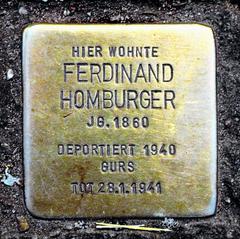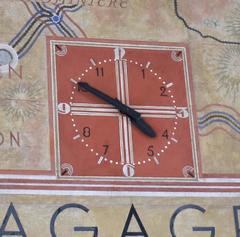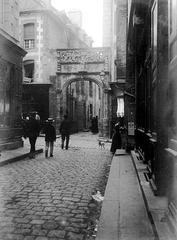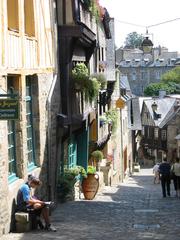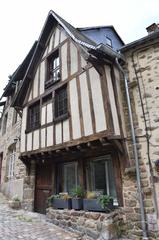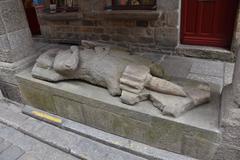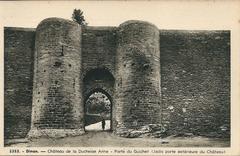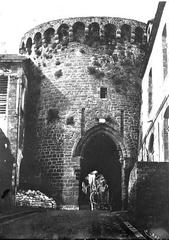
Château de Dinan: Visiting Hours, Tickets, and Comprehensive Travel Guide
Date: 04/07/2025
Introduction
Nestled in the heart of Brittany, France, the Château de Dinan is a formidable symbol of medieval architecture, Breton history, and cultural heritage. Known as the Tower Palace of the Dukes of Brittany, this imposing fortress offers panoramic views over the Rance River and the picturesque town of Dinan. Its origins date back to the 11th century, with notable mentions in the Bayeux Tapestry, highlighting Dinan’s strategic importance during the Middle Ages (travelfranceonline.com).
Constructed in the late 14th century under Duke Jean IV of Brittany, the château was designed as both a defensive stronghold and a luxurious residence, rivaling royal fortresses like the Château de Vincennes (dinan-capfrehel.com). Today, it stands as a well-preserved historical monument and a vibrant cultural center, hosting exhibitions, interactive displays, and the renowned Fête des Remparts medieval festival (dinan-capfrehel.com).
This guide provides detailed historical context, practical visitor information, and recommendations for exploring both the château and Dinan’s other historical sites, ensuring a rewarding visit for all.
Table of Contents
- Historical Overview
- Visitor Information
- Visuals and Media
- Frequently Asked Questions (FAQ)
- Conclusion
- References
Historical Overview
Origins and Early History
Dinan’s fortifications were first established in the 11th century, with the town’s significance immortalized in the Bayeux Tapestry, which depicts the 1065 siege by William the Conqueror. This event highlighted Dinan’s early strategic and military importance in Brittany (travelfranceonline.com).
In 1283, Dinan was elevated to a duchy, prompting further defensive enhancements. The region’s tumultuous history, including the War of the Breton Succession and the Hundred Years’ War, shaped the town’s formidable ramparts and laid the groundwork for the château’s later construction.
Construction and Architectural Features
Commissioned by Duke Jean IV in the 1380s, the Château de Dinan was both a military fortress and a princely residence. Key architectural highlights include:
- Keep (Donjon de la Duchesse Anne): A massive cylindrical tower housing ceremonial rooms, living quarters, and a panoramic terrace (dinan-capfrehel.com).
- Curtain Walls and Towers: Integrated into Dinan’s ramparts, the château is complemented by 2,700 meters of walls and 14 guard towers (10 survive today) (travelfranceonline.com).
- Defensive Innovations: Features such as thick walls, machicolations, and the 13th-century Porte du Guichet exemplify medieval military design.
- Interior Spaces: Includes a chapel, banquet halls, kitchens, armory, and even prison cells with historic graffiti (InfoBretagne).
The castle’s architectural balance between defense and ducal comfort, along with elegant stonework and preserved wall paintings, makes it a remarkable example of late medieval design (nomads-travel-guide.com).
Role in Regional History
The château played a crucial administrative and military role, protecting Dinan’s autonomy and prosperity during the Middle Ages. Its ramparts and keep became enduring symbols of local pride and resilience, especially during conflicts like the Hundred Years’ War (about-france.com).
After Brittany’s union with France in the 16th century, the château’s military function declined, but it continued to serve as a symbol of Breton identity and autonomy.
Preservation and Modern Significance
Although advances in artillery rendered traditional fortresses obsolete, the Château de Dinan was preserved and repurposed over the centuries. Today, it operates as a museum featuring medieval artifacts, interactive exhibits, and immersive scenography. Restoration efforts in recent decades have ensured its survival and adaptation for cultural events, including the biennial Fête des Remparts, which brings the Middle Ages to life with reenactments and workshops (dinan-capfrehel.com).
Visitor Information
Location and Access
Château de Dinan is centrally located at 9 rue du Château, adjacent to the town’s ramparts and near Dinan’s Tourist Information Center (Dreamer at Heart). Paid parking is available at DuGuesclin, Centre Historique, and Hôtel de Ville lots. Dinan is accessible by train (Rennes-Dinan, about 1 hour 12 minutes), bus (from Saint-Malo), or scenic river cruise (Haswell Travelled).
Visiting Hours and Ticket Prices
- May to September: Open daily, usually 10:30 a.m. – 7:00 p.m.
- April, October to December: Open afternoons only (except Mondays), typically 1:30 p.m. – 6:30 p.m.
- January to March: Closed (France This Way).
Admission:
- Adults: €8.00
- Reduced (under 18s, students, job seekers, people with disabilities): €5.00
- Children under 6: Free (Dinan Cap Fréhel)
Tickets are sold at the entrance; online sales are not currently available.
Accessibility
Due to the château’s medieval architecture, some areas (especially towers and subterranean passages) may be difficult to access for visitors with limited mobility. The main courtyard and several ground-level exhibits are accessible, and assistance is available upon request.
Guided Tours and Travel Tips
- Tours: Self-guided visits feature informative panels in multiple languages. Guided tours are offered seasonally and during special events.
- Best Time to Visit: May to September for longer hours and pleasant weather. Arrive early to avoid crowds, especially during festivals or market days (Wanderlog).
- Visit Duration: Allow 1–2 hours for the château, plus extra time for ramparts and the old town.
- Footwear: Wear comfortable shoes for cobblestones and stairs.
Family-Friendly Activities
The château engages visitors of all ages with interactive exhibits, such as trying on knight’s armor, mock trials, and themed scavenger hunts. Educational panels bring Dinan’s medieval past to life (Dinan Cap Fréhel).
Dining, Accommodation, and Nearby Attractions
- Dining: Numerous cafés and restaurants surround the historic center and ramparts.
- Accommodation: Options include hotels, guesthouses, and campsites along the Rance River.
- Nearby Sites: Don’t miss the medieval center with half-timbered houses, Rue du Jerzual, Basilica of Saint-Sauveur, the Church of Saint-Malo, and the picturesque Port of Dinan (France This Way; Tourist Places Guide).
- Day Trips: Consider nearby villages like Saint-Suliac and Dinard for more Breton charm.
Visuals and Media
High-quality images, virtual tours, and maps are available on the official tourism website. Alt tags such as “Château de Dinan panoramic terrace view,” “Medieval towers at Château de Dinan,” and “Dinan historical sites and ramparts” can help you plan your visit and enhance your experience (Dinan Cap Fréhel).
Frequently Asked Questions (FAQ)
Q: What are the Château de Dinan visiting hours?
A: May–September: 10:30 a.m. – 7:00 p.m. October–December: afternoons only (except Mondays). Closed January–March.
Q: How much do tickets cost?
A: Adults: €8.00; reduced: €5.00; children under 6: free.
Q: Is the château accessible to visitors with disabilities?
A: Some ground-level areas are accessible, but towers and passages may be difficult. Contact the site for guidance.
Q: Are guided tours available?
A: Self-guided tours are standard. Guided tours and special events are offered seasonally; check ahead.
Q: Can I buy tickets online?
A: Tickets are available at the entrance; online sales are not yet offered.
Q: What else should I see nearby?
A: Explore the medieval town center, ramparts, basilicas, and the scenic port area.
Conclusion
The Château de Dinan offers an immersive journey through medieval history, architecture, and Breton culture. With its strategic location, well-preserved ramparts, engaging exhibits, and breathtaking views, it stands out as one of France’s best-preserved medieval castles. Plan your visit by checking the latest opening hours and ticket prices, using official tourism resources, and enhancing your exploration with guided audio tours like Audiala.
Whether you are a history enthusiast, family traveler, or cultural explorer, Château de Dinan—and the charming town around it—promise an unforgettable experience. Begin your journey through Brittany’s medieval heritage today!
References and Further Reading
- Dinan Ramparts – Historic City (travelfranceonline.com)
- Château de Dinan – Tower Palace of the Dukes of Brittany (dinan-capfrehel.com)
- Château de Dinan (nomads-travel-guide.com)
- Château de Dinan – Dinan Cap Fréhel Tourism (dinan-capfrehel.com)
- Château de Dinan – France This Way (francethisway.com)
- Dinan Cap Fréhel – Our Essentials (dinan-capfrehel.com)
- Monsieur de France – Visit Dinan, Brittany (monsieur-de-france.com)
- Dreamer at Heart – Dinan (Dreamer at Heart)
- Haswell Travelled – Dinan (Haswell Travelled)
- Tourist Places Guide – Dinan (Tourist Places Guide)
- France Adventurer – Things to Do in Dinan (France Adventurer)
- InfoBretagne – Dinan Château (InfoBretagne)
- Wanderlog – Dinan in July (Wanderlog)
- Solosophie – Medieval Town of Dinan (solosophie.com)
- Britannica – Dinan (britannica.com)
- About France – Dinan (about-france.com)
- Wikipedia – Château de Dinan (Wikipedia)











